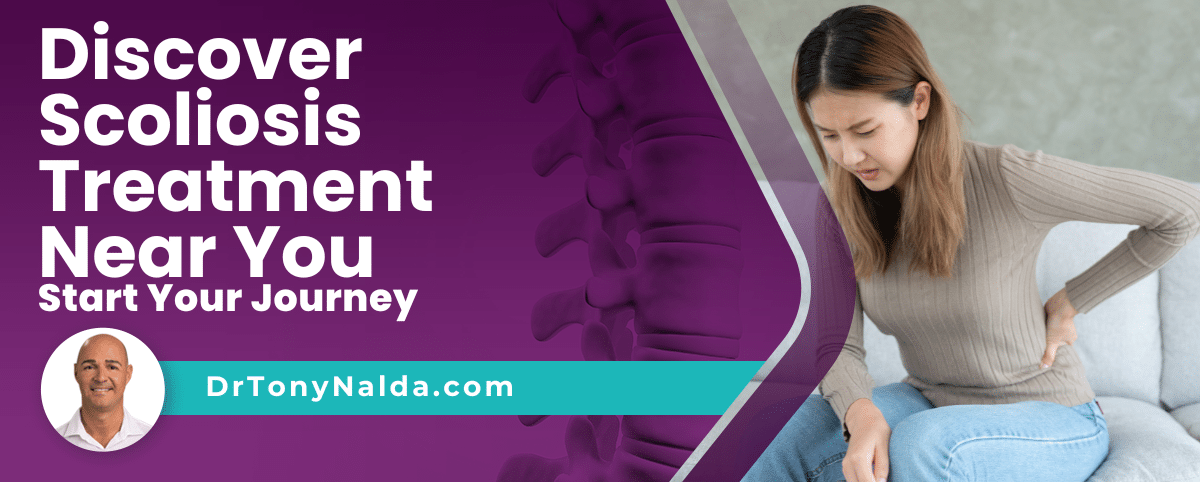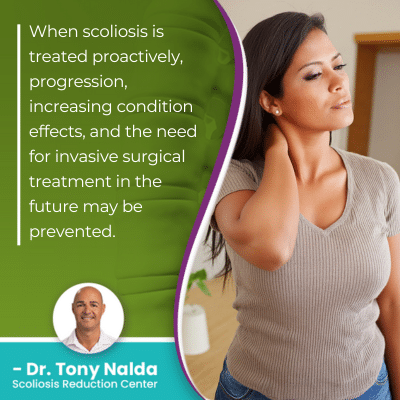Discover Scoliosis Treatment Near You: Start Your Journey

Scoliosis treatment can involve different disciplines, and having access to multiple scoliosis-specific types of treatment under one roof can be very beneficial. Here at the Center, patients benefit from a proactive conservative treatment approach that combines the power of chiropractic care, physical therapy, scoliosis exercises, and rehabilitation.
If you're looking for scoliosis treatment near you, look no further than Celebration, Orlando, Florida's Scoliosis Reduction Center. Your scoliosis journey starts with a diagnosis, and conditions are shaped by how a diagnosis is responded to with treatment.
How a diagnosis of scoliosis is responded to with treatment is the most important decision facing scoliosis patients.
Table of Contents
What is Scoliosis Complex to Treat?
There are a number of spinal conditions that cause a loss of the spine's healthy and natural curves, but scoliosis has some characteristics that make it particularly complex to treat.
Scoliosis is a structural spinal condition that causes the development of an unnatural sideways-bending spinal curve, but a true scoliotic curve doesn't just bend to the side, but also twists; the rotational component makes scoliosis a complex 3-dimensional condition.
Scoliosis is Progressive
 One of the biggest challenges to treating scoliosis is that it's a progressive condition, meaning it has it in its nature to get worse over time, and this means the size of the unnatural spinal curve is going to increase, along with the condition's uneven forces, and their effects.
One of the biggest challenges to treating scoliosis is that it's a progressive condition, meaning it has it in its nature to get worse over time, and this means the size of the unnatural spinal curve is going to increase, along with the condition's uneven forces, and their effects.
So a focus of treatment is on how to counteract that progressive nature while restoring as much of the spine's healthy curves as possible.
There are also different types of scoliosis, and while we don't know why most cases of scoliosis develop initially, we know it's growth that makes them progress, so childhood scoliosis should always be taken seriously.
Different Types of Scoliosis
There are also different types of scoliosis that can complicate the treatment process with unique symptoms and treatment needs.
Part of diagnosing scoliosis involves further classifying conditions based on condition characteristics, and type is an important one because treatment has to address a condition's underlying cause, or it's only addressing the condition's symptoms, but not the condition itself: an important distinction.
The main type of scoliosis to affect all ages is idiopathic scoliosis, and this type has no single-known cause; it's, instead, thought to be multifactorial.
Idiopathic scoliosis accounts for approximately 80 percent of known diagnosed cases, and the remaining 20 percent are associated with known causes: neuromuscular scoliosis that's caused by neuromuscular conditions, congenital scoliosis that's caused by a malformed spine that develops in utero, and degenerative scoliosis that's caused by natural age-related spinal degeneration.
For treatment to be successful, the underlying cause has to be addressed, and as all types of scoliosis are progressive, the sooner treatment is started, the better.
Scoliosis ranges widely in severity: a key factor treatment plans are shaped around.
Condition Severity
Condition severity is important because a minimum size of curvature is needed to be considered a true scoliosis, and this is determined with a measurement known as Cobb angle.
A minimum Cobb angle of 10 degrees, and rotation, is necessary to reach a scoliosis diagnosis, and the measurement involves drawing lines from the tops and bottoms of the curve's most-tilted vertebrae at its apex, and the resulting angle is expressed in degrees.
The higher the Cobb angle, the more severe the condition, and the more likely it is that its effects are going to be noticeable; in children, the main condition effects are postural changes, and in adults, the main symptom of scoliosis is pain.
- Mild scoliosis: Cobb angle measurement of between 10 and 25 degrees
- Moderate scoliosis: Cobb angle measurements of between 25 and 40 degrees
- Severe scoliosis: Cobb angle of 40+ degrees
- Very-severe scoliosis: Cobb angle of 80+ degrees
The effects of scoliosis will vary based on patient age, condition type, severity, and curvature location.
There are three main spinal sections, and scoliosis can develop in any one, or in more than one as a combined scoliosis: the cervical spine (neck), thoracic spine (middle/upper back), and the lumbar spine (lower back).
In most cases, the area of the body located the closest to the affected spinal section is going to feel the majority of its direct effects.
Once a diagnosis is reached, the most important decision is how to treat it moving forward, and for those in the Celebration, Florida area looking for scoliosis treatment, the Scoliosis Reduction Center offers its patients a number of benefits.
Conservative Nonsurgical Scoliosis Treatment
Here at the Scoliosis Reduction Center, patients are provided with a proactive nonsurgical scoliosis treatment alternative.
 Traditional scoliosis treatment offers a surgical response when/if conditions progress to become severe, but they do little to nothing to work towards preventing that progression; it's a more reactive approach than proactive.
Traditional scoliosis treatment offers a surgical response when/if conditions progress to become severe, but they do little to nothing to work towards preventing that progression; it's a more reactive approach than proactive.
Conservative treatment combines the power of multiple different types of scoliosis treatment so treatment plans can be fully customized and conditions can be impacted on every level.
As growth is the trigger for progression, particularly in children, rapid-phase progression is a concern, so treatment has to work towards reducing the size of the scoliotic curve on a structural level, and holding it there despite the constant trigger of growth.
Regardless of type or severity, all cases of scoliosis require treatment because as a progressive condition, they are not going to get better on their own.
Childhood scoliosis treatment, adult scoliosis treatment, all types of scoliosis treatment are going to involve managing a lifelong condition, and conservative treatment is aligned with the spine's movement-based design and works towards preserving as much of the spine's natural curves as possible.
So if you're in the Celebration, Orlando area and are looking for guidance and/or scoliosis treatment, the Center has a number of benefits, including being able to access multiple different facets of treatment under one roof.
Scoliosis Reduction Center Treatment Approach
As a scoliosis chiropractor certified in a number of different treatment modalities, Dr. Tony Nalda can fully customize each and every treatment plan to address the specific needs of his patients.
Maintaining long-term spinal health and function is a priority of conservative treatment, and while spinal fusion surgery can help straighten a bent spine, the way it does so is invasive and risky and can cost the spine in terms of its overall strength and flexibility.
A scoliosis specialist is needed to address the condition's complex 3-dimensional and progressive nature, and conservative treatment proves that many scoliosis cases don't require surgery.
While there are no treatment guarantees, early intervention does increase the likelihood of treatment success because milder conditions are simpler to treat; as scoliosis progresses, it gets more complex to treat and more difficult to reverse its effects.
With condition-specific chiropractic care, physical therapy, scoliosis exercises, corrective bracing, and rehabilitation, there are fewer limits to what can be achieved without having to face the risks of scoliosis surgery.
When scoliosis is treated proactively, progression, increasing condition effects, and the need for invasive surgical treatment in the future may be prevented.
Chiropractic care can work towards reducing the size of the curve by adjusting the position of the curve's most-tilted vertebrae back into alignment with the rest of the spine.
Physical therapy and scoliosis exercises can help prepare the spine and its surroundings for treatment, address poor posture, muscle asymmetry, and increase core strength so the spine's optimally supported.
Corrective bracing can be particularly helpful for treating childhood scoliosis as growing spines are more responsive to bracing, and an ultra-corrective brace like the ScoliBrace can help augment corrective treatment results by pushing the spine into a corrective position.
Rehabilitation can involve leading a spine-friendly lifestyle, continued chiropractic care, and the prescription of a series of scoliosis-specific exercises that can be performed from home.
Conclusion
The best way to minimize the effects of scoliosis is to treat it proactively, and for those looking for a proactive conservative nonsurgical treatment option located in the Celebration, Orlando area, the Scoliosis Reduction Center has a lot to offer.
Not only does the Center give patients access to multiple effective treatment options under one roof, there is also a state-of-the-art equipment room for exercise-based treatment that can help work towards preventing further progression.
Scoliosis can range widely in severity from mild to moderate and severe to very severe, and the best time to start treatment is always now; in most cases, it's more effective to work towards preventing progression and increasing condition effects than it is to reverse them once established.
Adult scoliosis treatment can also be found at the Center and involves chiropractic care and physical therapy improving the spine's stability.
Scoliosis treatment should be taken seriously because it's about managing an ongoing condition for the best quality of life.
Dr. Tony Nalda
DOCTOR OF CHIROPRACTIC
After receiving an undergraduate degree in psychology and his Doctorate of Chiropractic from Life University, Dr. Nalda settled in Celebration, Florida and proceeded to build one of Central Florida’s most successful chiropractic clinics.
His experience with patients suffering from scoliosis, and the confusion and frustration they faced, led him to seek a specialty in scoliosis care. In 2006 he completed his Intensive Care Certification from CLEAR Institute, a leading scoliosis educational and certification center.
About Dr. Tony Nalda
 Ready to explore scoliosis treatment? Contact Us Now
Ready to explore scoliosis treatment? Contact Us Now





